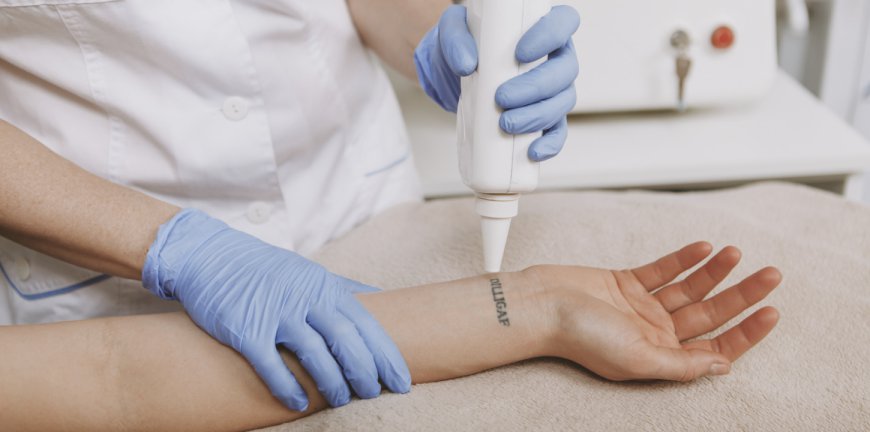Best Laser Tattoo Removal for All Skin Types
Opt for Laser Tattoo Removal in Dubai to permanently get rid of your tattoos without suffering from botched results.

Tattoos can hold significant meaning for many individuals, but as life changes, so do our preferences and the perceptions of those tattoos. For some, this leads to the desire to remove unwanted ink. Laser tattoo removal has emerged as one of the most effective methods to achieve this, offering a safe and efficient solution. In this article, we will explore the best laser tattoo removal options for all skin types, focusing on technology, procedures, and aftercare without discussing costs.
Understanding Laser Tattoo Removal
Laser Tattoo Removal in Dubai works by using concentrated light beams to break down the ink particles in the skin. This technique is favored for its precision and ability to target specific colors without damaging surrounding tissues. Various types of lasers are used in the removal process, each designed to tackle different ink pigments and skin types effectively.
Types of Lasers Used in Tattoo Removal
1. Q-Switched Lasers
Q-switched lasers are among the most common types used for tattoo removal. They emit short bursts of high-intensity light that can effectively target and break down tattoo ink. These lasers are particularly effective for darker ink colors, such as black and blue, and are suitable for various skin types.
2. Pico Lasers
Pico lasers represent the latest advancement in laser technology for tattoo removal. They operate at a higher frequency than Q-switched lasers, resulting in faster and more efficient ink particle fragmentation. Pico lasers are beneficial for treating multi-colored tattoos and can be adjusted based on the specific skin type and tattoo characteristics.
3. Fractional Lasers
Fractional lasers work differently than Q-switched and pico lasers. Instead of focusing on the entire tattoo, fractional lasers target only a fraction of the skin. This method promotes faster healing and is ideal for individuals with sensitive skin or those prone to scarring. Fractional lasers can treat various ink colors and skin tones, making them versatile in tattoo removal.
Choosing the Right Laser for Your Skin Type
Skin Types and Laser Compatibility
The Fitzpatrick scale is commonly used to classify skin types based on their response to UV exposure. When considering laser tattoo removal, understanding your skin type is crucial in selecting the appropriate laser technology.
- Type I: Very fair skin that burns easily and rarely tans. This skin type responds well to Q-switched lasers.
- Type II: Fair skin that burns easily and tans minimally. Both Q-switched and pico lasers are effective options for this skin type.
- Type III: Medium skin that tans moderately. This skin type can benefit from a wider range of lasers, including fractional lasers.
- Type IV: Olive skin that tans easily. Pico and fractional lasers are suitable, as they minimize the risk of hyperpigmentation.
- Type V: Brown skin that rarely burns. Fractional lasers are often preferred to reduce the risk of pigmentation changes.
- Type VI: Dark brown to black skin that never burns. Fractional lasers and specialized pico lasers are recommended to ensure safe removal without scarring.
Consultation with a Professional
Before undergoing laser tattoo removal, it is essential to consult with a qualified practitioner who can assess your skin type and the specific characteristics of your tattoo. During the consultation, the practitioner will discuss your medical history, any previous skin treatments, and your expectations for the procedure. This personalized approach ensures that the selected laser technology aligns with your skin type and tattoo characteristics.
The Tattoo Removal Process
Pre-Treatment Care
Prior to your laser treatment, your practitioner will provide guidelines to prepare your skin. This may include avoiding sun exposure, refraining from certain medications, and maintaining healthy skin hydration. Proper pre-treatment care can enhance the effectiveness of the procedure and minimize potential side effects.
Treatment Sessions
Laser tattoo removal typically requires multiple sessions, depending on factors such as tattoo size, ink density, and skin type. During each session, the practitioner will use the chosen laser to target the tattooed area. Patients often describe the sensation as similar to the snap of a rubber band against the skin. The process generally lasts between 15 to 60 minutes, depending on the tattoo's size.
Post-Treatment Care
After each session, it is essential to follow the aftercare instructions provided by your practitioner. Common recommendations include keeping the treated area clean and moisturized, avoiding direct sunlight, and steering clear of harsh chemicals or exfoliants. Following these guidelines promotes optimal healing and reduces the risk of complications.
Understanding Results and Expectations
While laser tattoo removal is highly effective, results vary based on individual factors such as skin type, ink color, and the tattoo's location. Some tattoos may fade significantly after just a few sessions, while others may require more extensive treatment. Patience is crucial, as complete removal can take several months to achieve.
Monitoring Progress
Throughout the process, regular check-ins with your practitioner can help monitor progress and adjust treatment plans if necessary. Tracking changes in the tattoo's appearance allows for a tailored approach, ensuring that your unique needs are addressed.
Conclusion
Laser tattoo removal offers a reliable solution for individuals looking to erase unwanted tattoos safely and effectively. By understanding the different types of lasers, how they interact with various skin types, and the importance of professional consultation, you can make informed decisions on your tattoo removal journey. With the right approach, achieving clear skin free from unwanted ink is within reach. Always consult with a qualified practitioner to ensure the best possible outcomes for your unique needs.
